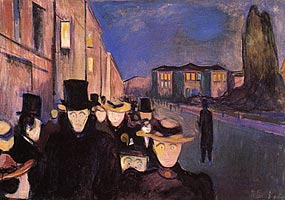 |

  

  

  
|
Anxiety
Paintings > Evening on Karl Johan
Your
Comments
Elizabeth H. wrote on Nov 2, 2003:
Setting
The background of the painting brings the whole work together as one idea. The
sun has set in the background. It has died, just as every human will inevitably
pass away. The horrified crowd walks away from death, avoids it, while the lone
figure stares at the coming night and acknowledges its imminence. The man, the
existentialist of the painting, knows of his separation from the crowd, and understands
that death is unavoidable. All lines of the painting point the eye towards the
back of the painting, the place where the crowds flee from, the place where the
man watches, and the place where the sun dies....
Jamie
Pyette wrote on Oct 18, 2001:
Ignorance of society turns its back to those of us who won't turn eyes away
from the different. Not unlike the painted crowd, many eyes won't see what
is deep, only surface. The lone walking man denies the crowd, thus denying
society.
Ian
R. Douglas wrote on Jul 27, 2001:
The greatest weight
Searing, isn't it? It is said in Eastern philosophy that the world we encounter
is a reflection of the world that we are. I am now 29 years of age. I recognize
the moment of silence that descends on a soul as one passes through (though
only just past), that inanimate ignorance of youth. No, this is not pejorative:
how I wish I could walk and breathe and live again free of hurt, memory, knowledge.
For those who look to this picture -- like I did -- and feel within their souls
the greatest weight of sadness, this little thing found me recently which has
helped me: a very short (3-4 pages only) essay by Kleist entitled "On the Marionette
Theatre." It can be found in a book by Idris Parry entitled "Hand to Mouth." Eduardo
Galeano helps some too, but Kleist really speaks to this picture, so far as
I can see: the haunting terror of the total uselessness of life. As one of
your other commentators says it perfectly, "I miss everything I'll never be." ...
Perhaps though we don't know; perhaps, though, we can walk on. Perhaps (and
this is why I write, why I comment), we can find -- as Kleist hopes -- a route
around the "back of the world" if the entrance to Paradise that we face is
blocked. This vision need not be destiny; it is a momentary pause. Remember
you are breathing. Walk on gently.
Milk wrote
on Jun 9, 2001:
The amazement stare
The people on the right do have an amazed, sad, anxious look on their eyes.
I believe it's the inadequacy that the character on the right produces... The
way he merges with the evening mood, the way he is walking with a strange air...
like he is far away from the elements which produce the perspective, and they
are right there... I think they are bothered, uncomfortable by the way the
person in the right isn't walking amongst them, by the way he doesn't seem
to be in the same place. And they cannot pull away, hence the closeness to
the perspective, and to the viewer.
Rob wrote
on Apr 21, 2001:
The Eyes
Look at their eyes, and who is that mysterious figure to the right of the crowd?
It seems to me that these people are walking away from something although they
are walking towards the viewer, I also believe that the people walking in front
have just experienced something, something that they aren't discussing but
they all know what the others are thinking, and they pass other pedestrians
and don't bother to warn them of what they are going to, just look at their
eyes...
Write
a comment
Credits
Picture: Edvard
Munch: The Frieze of Life.
|
 |
 |












